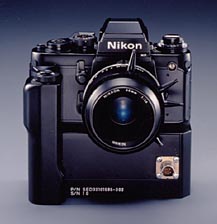
Nikon Photomic FTN
used in Apollo
15 | Cameras
for a higher cause
After W.W. II, the U.S.A. had been
involved in a race for space with the U.S.S.R., to gain ultimate
superpower status.
Both countries continued their work and research,
and were able to execute a manned space flight by the 1960's.
Around
this time they had started using cameras for recording.
At first, NASA
(National Aeronautics and Space Administration) used primarily 70mm-format
films.
They found, however, that they needed a more portable camera
for more active shooting situations.
Nikon, whose cameras had a
reputation for reliability in the U.S. market, was selected as a special
manufacturer of 35mm cameras for NASA.
Although the Nikon U.S.
distributor accepted the order of the special cameras for NASA, a special
team at Nippon Kogaku's Ohi Plant took charge of product development.

Nikon Photomic FTN
used in Apollo
15 | Space
photography
A camera used in space would be subjected to a
vacuum and zero-gravity conditions.
As the spacecraft compartment is
airtight, it is crucial that harmful gas or fire never be generated.
The camera should be easy to operate for someone wearing gloves.
And reliability became a major issue.
The rays of the sun and their
reflection on the camera body may be stronger than those on the earth's
surface, and the weight of cargo aboard the craft should be limited as
much as possible for launching, so there's no room for a spare camera in
case the main one malfunctions.
In order to meet these demanding
conditions, Nippon Kogaku's special product development team used the
Nikon F as the base body and made numerous modifications.
For
example, the leather-like body cover generally used for the Nikon F
had been changed to a metal plate painted in matte black.
Adhesive
used adhered to NASA specifications.
For plastic parts, materials
generally used for F cameras had to be changed to specified
parts.
The battery chamber was designed to prevent accidental leakage
from the camera body. Electrical parts were soldered in accordance with
NASA standards.
The standard thickness of the plating was modified.
Dimensions were also changed to accommodate thinner polyester-based films.
Modifications made to operating parts included an enlarged finger pad
for the film advance lever, a larger film rewinding knob, and enlarged
film counter figures and windows.
Interchangeable lenses were also
modified.
The addition of two horns on the focusing ring was the most
significant change.
It made focusing simple as the user needed only to
rotate the ring using the horn.
NASA's standards for shutter accuracy
were even more stringent than those of Nikon.

Nikon F
used in
Skylab | Nikon — and users — benefitted from NASA
experience
The technologies Nikon used in developing cameras
for NASA finally went into use in 1971.
The modified F camera
and some modified interchangeable lenses were provided to NASA for the
Apollo 15 mission.
Then, in 1973, a modified version of the F
camera with a motor drive and modified lens were supplied for use aboard
Skylab.

Nikon F
used in
Skylab | The cameras Nikon developed for use
in space exploration are still in use today, and maintenance is still
being provided.
These NASA cameras were of course very costly.
It
is said that Nippon Kogaku took heavy losses. However, these losses were
balanced out by the value of the experience in the space project. Nippon
Kogaku took what they had learned and used it to improve the reliability
and operational performance of Nikon products.
The development of the
camera for NASA using the Nikon F body as a base and the development of
the Nikon F2 occurred in parallel.
NASA did not require
increasing numbers of the modified F2 cameras, and in fact the
camera was never actually manufactured.

Nikon F3
"Big
Camera" | F3
and F4 cameras for NASA
After some time had passed, Nikon
went to work on camera models for NASA that were based on the F3
body.
There were the "Small Camera", which was equipped with a motor
drive, and the "Big Camera" for long film that were delivered to NASA for
use aboard the space shuttle in 1981.
While the Nikon F3 was
still being developed and many issues had yet to be decided, NASA went
ahead and formally declared the Nikon F3 to be an official NASA
camera.
The F3 models for NASA, and those for mass consumption,
were developed side-by-side at the Ohi Plant.
Another special team was
assigned to the development of the F3 for NASA. The "Big Camera"
was equipped with an interchangeable film back and used a thinner special
long film for bulk loading.
Members of the special team needed to
concentrate on developing a new technology that would accelerate film
advancement.
After much effort and brainstorming, they solved the
problem and succeeded in delivering the cameras for the space
shuttle.
The F3 for NASA had many of the same features as the
F3 for mass consumption, including internal parts.
Compared to
the modified F models for NASA, the F3 for NASA was much
more similar to the F3 models made for the public.

Nikon F3
"Small
Camera" | In 1989, Nikon delivered the
modified F4 to NASA. There were only a few small differences
between the modified F4 and mass-consumption F4
models.
Nikon positively applied the experiences obtained during
development of NASA cameras to the development of cameras for the general
public.
At the same time, NASA learned about the specifications that
were required for the camera's use in space.
These were the reasons
why very few modifications were required for recent NASA
cameras.
Products, brands
and companies names are trademarks or registered trademarks of their
respective companies.
Copyright  1997 / 1999 TATENO, Yokoyuki 1997 / 1999 TATENO, Yokoyuki
|